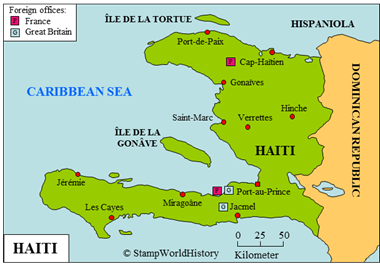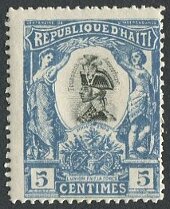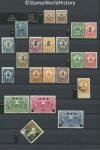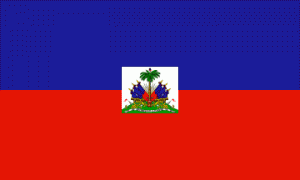
Haiti
Quick reference
General issues: Republic 1881-Present
Country name on general issues: Haiti, Haïti
Currency: 1 Piaster/1 Gourde = 100 Centimes 1881-Present
Population: 1 294 000 in 1901, 10 320 000 in 2013
Political history Haiti
Colonization
Haiti is located in the Caribbean on the island of Hispaniola, one of the Greater Antilles. Prior to colonization, Hispaniola was inhabited by the Taino, an Ameridian people found on many of the islands in the Caribbean. The first European to explore Hispaniola was Christopher Columbus in 1492. Hispaniola was first settled by the Spanish in 1496 and established the colony of Santo Domingo. In the early days of colonization, the island was the staging ground for the further exploration and conquest of Central and South America. Once the Viceroyalties of New Spain and Peru were formed, Hispaniola lost importance. In the 17th century the French settled on the Île de la Tortue[1]Also known as Tortuga or Turtle Island. and subsequently on Hispaniola. The French gradually extended their influence, and in 1697 Spain ceded the western part of Hispaniola to France. The French established the colony of Saint-Domingue and developed Saint-Domingue as a plantations colony. Sugar cane and, later, coffee were the most important crops. To man the plantations, large numbers of slaves were brought to Saint-Domingue. The slaves would come to outnumber the planters of European descent by ten to one. In the course of the 18th century, Saint-Domingue became one of the most wealthy colonies in the Caribbean and in the French Empire.
Independence
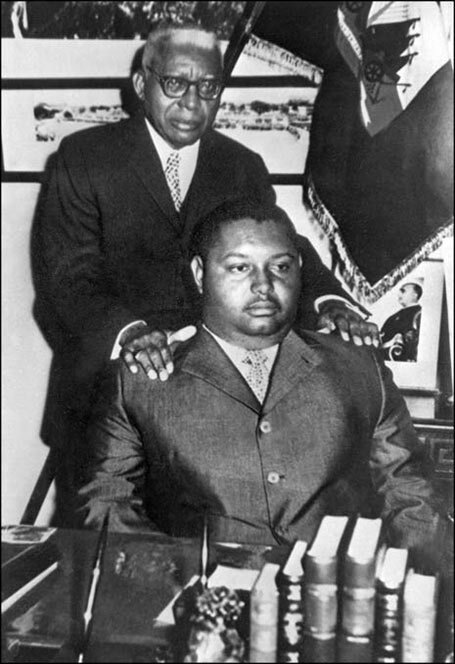
François Duvalier – standing – and his son Jean-Claude Duvalier ruled Haiti between 1957 and 1986. A rule characterized by repression and self enrichment.
In 1791, the slaves staged a revolt that sparked the Haitian Revolution and ended in Saint-Domingue gaining independence as the republic of Haiti in 1804. After independence, Haiti was strongly divided – in 1806 even dividing into two separate states. In 1820, Jean-Pierre Boyer, president since 1818, managed to unite Haiti. In 1822, Boyer annexed the neighboring Dominican Republic, shortly after it had gained independence from Spain in 1821 – the Dominican Republic regained independence in 1844. In 1843, Boyer was overthrown. From then until the present day, Haiti has known a large number of – military – governments, often gaining power through a coup d’état and often succeeding each other in rapid succession. An exception was the rule of François Duvalier, between 1957 and 1971, and of his son Jean-Claude Duvalier, between 1971 and 1986. François Duvalier – Papa Doc – consolidated his power through repression on a scale that caused the United States to suspend its aid for Haiti in 1961. Although Jean-Claude Duvalier – Baby Doc – relaxed the repression, increased opposition escalated into open rebellion in the 1980’s and Jean-Claude Duvalier was forced to resign in 1986. The first free democratic elections are deemed to be held in 1990 – the elected president, the leftist Jean-Bertrand Aristide, was, however, overthrown by the military the following year. Haiti has not achieved political stability, until today.
Foreign interventions
The political turmoil in Haiti has, on a number of occasions, led to foreign intervention. The United States occupied Haiti in 1915 and had a military presence in the country until 1934. An agreement was signed, in 1915, that gave the United States control over Haitian finances and a number of government institutions – making Haiti a de facto United States protectorate until the agreement was revoked in 1941. The United States again intervened in 1994 – followed by a presence of United Nations forces in 1994 and 1995 – and in 2004 – again, followed by a presence of United Nations forces that continues until today.
Economy and demographics
Economically, Haiti, once was the wealthiest colony in the Caribbean and turned into the poorest country in the Americas. Currently, Haiti ranks 210 out of 230 countries worldwide in terms of per capita GDP. On the United Nations Index of Human Development, Haiti is qualified s a Low Development Country, ranking 163 out of 188 countries. The population is 95% black – 5% of the population is mulatto or white. In the second half of the 20th century large numbers of Haitians emigrated – legally and illegally. Currently over 3 million Haitians live abroad.
Postal history Haiti
Haiti issued its first stamps in 1881, upon joining the UPU. The first ‘Liberty Head’ issues strongly resemble the French ‘Ceres’ issues and were printed by M.G. Richard in Paris. In the first half of the 20th century most stamps were printed by the American Banknote Co. in New York. The 1950’s, stamps were mainly printed by a number of different European printing houses, such as Courvoisier in Switzerland and Waterlow & Sons in Great Britain. With the exception of a short period in the late 1960’s and early 1970’s, Haiti has, both in the classic and the modern era, mainly issued stamps with themes of national interest. In the early 1970’s several sets were issued for the thematic collectors market that were not authorized by the Haitian postal authorities – the themes being Space Exploration, UPU and Audubon Birds.
The British and the French operated offices abroad in Haiti. The British opened offices in Jacmel in 1866 and in Port-au-Prince in 1869. The general issues of Great Britain were used in these offices from 1869. The French had offices in Cap-Haitien, from 1865, and in Port-au-Prince, from 1876, using the general issues of France. The foreign offices closed when Haiti joined the UPU in 1881.
Album pages
← Previous page: GuyanaNext page: Hawaii →

